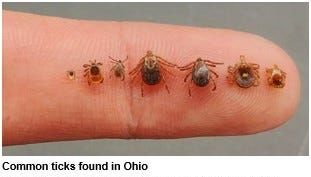Ad
related to: Do blacklegged ticks spread lyme disease?Advanced Testing and Treatment Options for Neurological Lyme Disease Symptoms. Overcoming the 3 Obstacles to Neurological Lyme Disease Treatment with Advanced Options.
- Lyme Disease
Learn More About Lyme Disease And
Their Treatment Options.
- Lyme Disease Treatment
Critical Obstacles in Lyme Disease
Treatment & Diagnosis Mastered
- Lyme Disease
Search results
- Lyme disease bacteria causing human infection in the United States are spread to people by blacklegged (Ixodes) ticks. In general, infected ticks must be attached for more than 24 hours to transmit infection; prompt tick removal can prevent transmission.
www.cdc.gov › lyme › causes
People also ask
Can blacklegged ticks cause Lyme disease?
How do blacklegged ticks spread lyme disease?
How many blacklegged ticks carry Lyme?
May 15, 2024 · Key points. Lyme disease bacteria causing human infection in the United States are spread to people by blacklegged ( Ixodes) ticks. In general, infected ticks must be attached for more than 24 hours to transmit infection; prompt tick removal can prevent transmission.
Lyme disease is caused by bacteria called Borrelia burgdorferi, and rarely, Borrelia mayonii. The bacteria are spread to people through the bites of infected blacklegged ticks. Under a microscope, the Lyme disease bacteria are corkscrew shaped. Where People Most Commonly Get Lyme Disease.
Jul 24, 2018 · The Western blacklegged tick ( Ixodes pacificus) is found west of the Rockies. Adults of both species have reddish-black bodies and are about the size of a sesame seed — smaller than most other...
- Paul Chisholm
- Overview
- Symptoms
- Causes
- Risk Factors
- Complications
- Prevention
Lyme disease is an illness caused by borrelia bacteria. Humans usually get Lyme disease from the bite of a tick carrying the bacteria. Ticks that can carry borrelia bacteria live throughout most of the United States. But Lyme disease is most common in the upper Midwest and the northeastern and mid-Atlantic states. It's also common in Europe and in ...
A tick bite may look like as a tiny, itchy bump on your skin, much like a mosquito bite. This doesn't mean you have a tick-borne disease. Many people will not notice they've had a tick bite. The symptoms of Lyme disease vary. They usually show up in stages. But the stages can overlap. And some people don't have symptoms of the typical early stage.
Lyme disease is caused by borrelia bacteria. In North America, the black-legged tick, also called the deer tick, mainly carry the bacteria. In Europe, a different species of borrelia causes Lyme disease. Ticks carry the bacteria. These ticks are known by a few names, including castor bean tick, sheep tick or deer tick.
Your risk for getting Lyme disease depends on if you spend time where they are likely to live. This includes the: 1. Region.Deer ticks that carry Lyme disease are widespread. They are mostly found in the upper Midwest, the northeastern and mid-Atlantic states, and in south central and southeastern Canada. The castor bean tick is found throughout Eu...
Some people with Lyme disease report symptoms that continue after treatment. These longer-lasting symptoms may include: 1. Arthritis that begins with Lyme disease and doesn't improve. 2. Body aches and pains. 3. Constant or frequent tiredness. 4. Memory complaints. These conditions are not clearly understood. Some people with these symptoms may be ...
The best way to prevent Lyme disease is to avoid tick bites when you are outdoors. Most ticks attach themselves to your lower legs and feet as you walk or work in grassy, wooded areas or overgrown fields. After a tick attaches to your body, it often crawls upward to find a spot to burrow into your skin. If you're in or plan to be in an area where t...
The ticks that carry the spirochete are: Black-legged deer tick (northeastern, mid-Atlantic, and North-Central U.S.) Western black-legged tick (Pacific coastal U.S.) Ticks prefer to live in wooded areas, low-growing grasslands, and yards. Not all ticks carry the Lyme disease bacteria.
In the midwestern and eastern United States, Ixodes scapularis or deer tick is the primary vector of Lyme disease. On the West Coast, the spirochete is carried by Ixodes pacificus or western black-legged tick. In the South, lone star ticks (Amblyomma americanum) can also transmit Lyme disease or a closely related illness.
Ad
related to: Do blacklegged ticks spread lyme disease?Advanced Testing and Treatment Options for Neurological Lyme Disease Symptoms. Overcoming the 3 Obstacles to Neurological Lyme Disease Treatment with Advanced Options.

